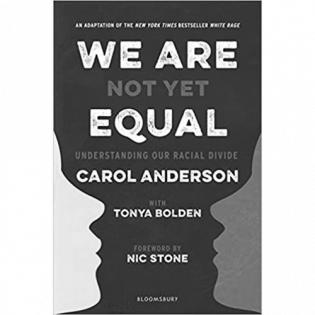We Are Not Yet Equal Literature Guide
This book is an adaptation for young people of the New York Times Bestselling book, White Rage. This book received several accolades including, an NAACP Image Award finalist book, a Kirkus Reviews Best Book of the Year, and a NYPL Best Book for Teens.
History texts often teach that the United States has made a straight line of progress toward Black equality. The reality is more complex: milestones like the end of slavery, school integration, and equal voting rights have all been met with racist legal and political maneuverings meant to limit that progress. We Are Not Yet Equal examines five of these moments: The end of the Civil War and Reconstruction was greeted with Jim Crow laws; the promise of new opportunities in the North during the Great Migration was limited when blacks were physically blocked from moving away from the South; the Supreme Court's landmark 1954 Brown v. Board of Education decision was met with the shutting down of public schools throughout the South; the Civil Rights Act of 1964 and Voting Rights Act of 1965 led to laws that disenfranchised millions of African American voters and a War on Drugs that disproportionately targeted blacks; and the election of President Obama led to an outburst of violence including the death of Black teen Michael Brown in Ferguson, Missouri as well as the election of Donald Trump.
Including photographs, archival imagery, extra context and resources specifically for teens, this book provides essential history to help work for an equal future.
Literature Guide by Anthony Salciccioli
Discussion Questions
- Racism may be defined as the belief that different races possess distinct characteristics, especially so as to distinguish them as inferior or superior to one another. What do you feel are the root causes of racism?
- Drawing upon your prior knowledge of United States History, what historical instances of racism can you recall? How do you feel these instances affect today’s world?
- In the Declaration of Independence Thomas Jefferson penned the words, “We hold these truths to be self-evident, that all men are created equal, that they are endowed by their Creator with certain unalienable Rights, that among these are Life, Liberty and the pursuit of Happiness.” How close is the America of today to matching this vision?
- We Are Not Yet Equal introduces the concept of, “white rage.” How does this concept differ from the other ways you may have thought about race relations in the past? What assumptions about race relations did you have coming into this book? Does the book contradict or support these assumptions?
- We Are Not Yet Equal focuses on certain watershed periods of U.S. History from the Civil War to President Obama’s second term. Why do you think the author chose to examine these times specifically? Are there other moments in history that can be looked at through the scope of white rage?
- For some, legality and morality might intersect, but there are many instances in this book where the author shows lawmakers, judges, and politicians using the law to serve their white rage. What are some instances from the book in which these occur? Can you think of other examples from current events where this has happened, too?
- What are ways in which people today can take action to address "white rage"? Think about legal and government systems that perpetuate bias.
- What role has the media played in perpetuating violence and inequity against African-Americans? Has this changed over time? What are some ways that you can identify media biases?
- How and where are teens affected by white rage? Do teens experience its effects differently than adults? Why or why not? How do these dynamics play out in a school setting?
- This book focuses primarily on African-Americans and Black History. How do the author’s arguments affect how you view the broader scope of U.S. History?
- Think about the title of the book. Do you agree with its assertion?
- Explore further books related to the themes in this book:
- Buried in Bitter Waters: The Hidden Story of Racial Cleansing in America by Elliot Jaspin (Basic Books, 2007).
- Freedom Summer Murders by Don Mitchell (Scholastic, 2014)
- From the War on Poverty to the War on Crime: The Making of Mass Incarceration in America by Elizabeth Hinton (Harvard University Press, 2016).
- The March Trilogy by John Lewis, Andrew Aydin, and Nate Powell (Top Shelf, 2013, 2015, 2016).
- The New Jim Crow: Mass Incarceration in the Age of Colorblindness by Michelle Alexander (The New Press, 2010).
- Stamped from the Beginning: The Definitive History of Racist Ideas in America by Ibram X. Kendi (Nation Books, 2016).
- We Were Eight Years in Power: An American Tragedy by Ta-Nehisi Coates (One World, 2017).
- A Wreath for Emmett Till by Marilyn Nelson (Houghton Mifflin Harcourt, 2005).
Activities
- Learn more about the struggle of African Americans by exploring the work of some of these organizations that support the concerns of African Americans and others who have experienced injustice.
- Watch this video of Professor Anderson speaking at Emory University “White Rage: The Unspoken Truth of Our Nation's Divide”.
- When you see injustice, call attention to it. Use words like, "We don't do that here." or "I'm uncomfortable with that."
- Read historical accounts of the philanthropy and social action of people from diverse backgrounds.
- Always seek reliable facts when information is shared. Make sure the source is reputable.
- Seek connection and community over division and name calling.
- After reading this book, students may be inspired to work to improve matters in their school and community. Follow the service-learning process to investigate, plan, and take action, then reflect and demonstrate impact.
- Encourage friends to learn about issues and vote. This Michigan voting guide provides tips and links for youth, even if they aren't old enough to vote.
